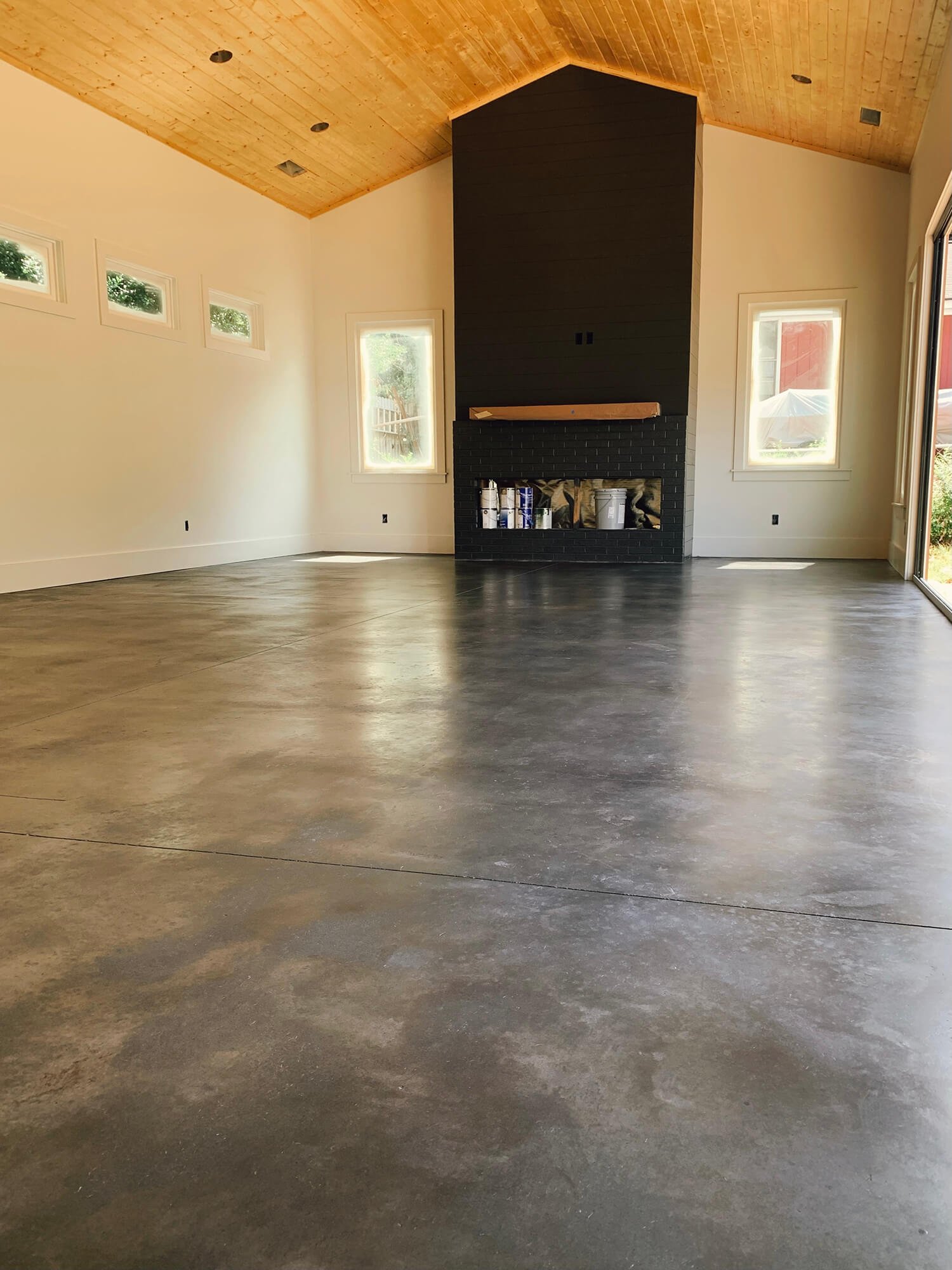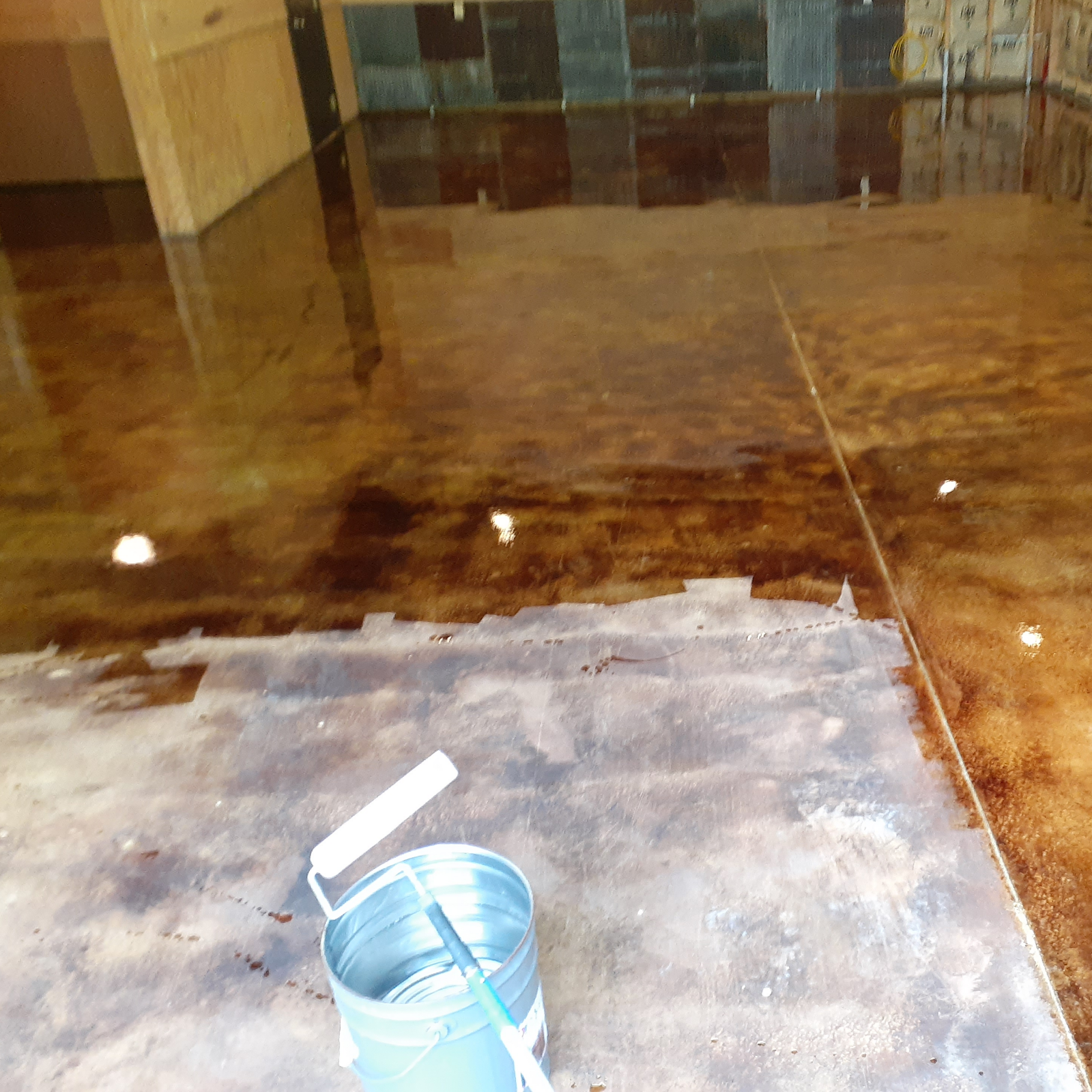Understanding the Various Sorts Of Stained Concrete for Your Following Job
Stained concrete deals various options that deal with different aesthetic and functional demands. Each kind offers distinctive characteristics that influence the last look and longevity of the surface. Understanding these distinctions is key for any person preparing a task. From rich, chemical responses of acid-based stains to the lively harmony of solid color stains, the choices can significantly affect the end result. What variables should one take into consideration when choosing the optimal tarnish for their details needs?
Summary of Stained Concrete
Stained concrete serves as a functional flooring alternative that can improve the visual appeal of numerous spaces. This strategy includes applying a coloring agent to the surface area of existing concrete, enabling for a broad range of design opportunities. Stained concrete is prominent in both domestic and business atmospheres, offering a sturdy and low-maintenance service that can resemble the look of natural materials like stone or tile.
The discoloration process can be performed making use of water-based or solvent-based items, each providing distinct aesthetic results. The final look is affected by variables such as the original concrete surface, the kind of discolor used, and the application method. Stained concrete not only beautifies exterior and interiors however also promotes sustainability by rejuvenating existing concrete structures. Because of this, it has gained traction amongst home owners and designers seeking both capability and style in their floor covering choices.
Acid-Based Stains: Features and Benefits

One-of-a-kind Shade Variations
Concrete surfaces can change dramatically with the application of acid-based stains, which use an abundant scheme of unique color variations. These stains penetrate the concrete, reacting chemically to generate dynamic planet tones that vary from deep browns and reds to soft eco-friendlies and blues. The resulting colors are typically variegated, developing a natural, marble-like appearance that boosts the concrete's character. Each application yields distinctive outcomes due to variations in the concrete's make-up and the discoloration technique utilized, making every task distinct. In addition, acid-based stains can be layered or combined with other methods to develop customized styles, enabling individual expression. This adaptability makes acid-based stains a preferred choice for both residential and business applications.
Chain Reaction Clarified
While several variables add to the effectiveness of acid-based stains, the underlying chemical reactions play an essential duty in their distinct attributes and advantages. These stains largely contain water, acid, and metallic salts. When used to concrete, the acid responds with the calcium hydroxide in the cement, producing a chemical makeover that results in permanent color changes. The metallic salts pass through the surface area and bond with the concrete, permitting a vast array of tones and tones. This response not just improves aesthetic appeal but additionally supplies longevity, making the color immune to fading and wear. In addition, acid-based stains can develop a variegated coating that simulates natural stone, more boosting their appeal for decorative concrete applications.
Surface Prep Work Relevance
Accomplishing suitable results with acid-based stains hinges on thorough surface area prep work. This necessary step guarantees that the concrete surface area is clean, without impurities, and correctly profiled for excellent tarnish absorption. Any kind of existing sealants, dirt, or oils can prevent the chemical reaction that produces the preferred color and surface, causing unequal or patchy outcomes.
Before using the stain, the concrete needs to be mechanically cleaned or pressure cleaned, complied with by a complete evaluation for splits or flaws that might require repair. In addition, confirming the surface area is adequately dried out will certainly boost tarnish adherence. By focusing on these primary procedures, the longevity and vibrancy of acid-based stains can be greatly enhanced, leading to a much more visually pleasing and resilient coating.
Water-Based Stains: Functions and Benefits

Water-based stains permeate the concrete, offering a much more translucent coating that highlights the natural appearance and variations of the surface area underneath. They are offered in a wide selection of colors, enabling imaginative versatility in layout. Furthermore, water-based stains are simpler to tidy up, requiring just water and soap, which simplifies the application process.
Their fast drying time improves performance, making them a practical option for both do it yourself lovers and specialists. In general, water-based stains supply an appealing combination of visual flexibility and straightforward buildings, making them a popular option for concrete enhancement tasks.
Solid Color Stains: Vivid Options for a Bold Appearance
Strong shade stains offer an efficient remedy for those seeking to create a bold and dynamic aesthetic on concrete surfaces. These stains supply a consistent pigmentation that can substantially enhance the visual charm of floors, outdoor patios, and driveways. Readily available in a wide spectrum of shades, strong shade stains enable creative expression, satisfying various design preferences.
One of the key benefits of solid color stains is their capacity to conceal imperfections, offering a fresh and sleek seek to maturing concrete - Austin Stained Concrete Floors. In addition, their solution commonly includes UV-resistant buildings, making certain durability and shade retention even in extreme weather
Application is uncomplicated, needing minimal preparation of the concrete surface. Once applied, strong color stains can be sealed for included security and luster, more elevating their visual quality. With their lively alternatives, strong shade stains are an exceptional option for those going for an impactful and natural design.
Semi-Transparent Stains: Achieving Deepness and Measurement
Semi-transparent stains supply a distinct approach to boosting concrete surfaces by providing deepness and measurement via different shade choices. Comprehending the application techniques is important for achieving the wanted result, while appropriate maintenance methods guarantee long life. This section will certainly explore these vital aspects to optimize the benefits of semi-transparent discoloration.
Shade Options Available
A wide range of color alternatives exists for semi-transparent stains, allowing home owners and developers to enhance the all-natural appeal of concrete surface areas. These stains are available in a range of tones, from earthy tones like browns and terracottas to lively shades such as blues and greens. The semi-transparent nature of these stains allows the underlying concrete to show via, developing a special depth and dimension that can enhance various style appearances. Additionally, integrating various shades can produce personalized shades, allowing a customized appearance for each job. This adaptability makes semi-transparent stains a prominent option for both exterior and interior applications, as they can harmonize with surrounding aspects while including visual interest to ordinary concrete.
Application Methods Explained
To achieve the desired deepness and measurement with semi-transparent stains, appropriate application techniques are important. First, surface area prep work is essential; the concrete must be tidy and totally free of any kind of contaminants. This commonly entails power washing and repairing any kind of fractures. Next, picking the appropriate applicator, such go to website as a sprayer, roller, or brush, can influence the final appearance. Sprayers enable an extra also application, while rollers can assist achieve appearance. It is vital to use the tarnish in slim, even coats, allowing each layer to dry prior to including another. Controling the application technique, such as differing stress or using different devices, can produce special impacts. Lastly, sealing the stained surface area enhances the vibrancy of the colors while providing defense.
Maintenance Ideal Practices
Regular upkeep is essential for maintaining the charm and honesty of surfaces treated with semi-transparent stains. To maintain these surface areas, routine cleaning is vital. Utilizing a pH-neutral cleaner and a soft-bristle broom will help get rid of dirt and debris without harming the stain. It is recommended to avoid use this link rough chemicals, as they can deteriorate the tarnish's look. Additionally, regular resealing each to three years can secure against wear and fading. This procedure entails cleaning up the surface area completely and applying a compatible sealer designed for stained concrete. Homeowners ought to additionally monitor for any type of indications of staining or damage and address these issues immediately to guarantee durable vibrancy and longevity. Complying with these best techniques will enhance the general life expectancy of semi-transparent stained surface areas.
Effects and Techniques: Personalizing Your Stained Concrete
Customizing stained concrete includes a selection of strategies that improve both looks and capability. Among these methods, layering different discolor colors can produce deepness and intricacy, enabling distinct visual impacts. Methods such as acid staining offer a variegated appearance, while water-based stains provide a much more consistent appearance.
Furthermore, integrating ornamental patterns, such as stenciling or inscription, can additionally customize the surface area, adding complex styles that deal with private tastes. Texturing the concrete, whether via marking or mop surfaces, introduces responsive components that not only enhance grasp yet likewise enhance visual passion.
Additionally, applying sealers can amplify the shade vibrancy and give security against wear. Modification strategies prolong beyond simple color; they can change a basic concrete slab right into a spectacular centerpiece, making it ideal for both property and business spaces. With careful option of impacts and methods, stained concrete can achieve a genuinely customized appearance.
Maintenance and Longevity of Stained Surfaces
Although stained concrete surface areas are recognized for their sturdiness and visual allure, preserving their stability is necessary for ensuring long life. Normal cleaning is essential; sweeping and mopping with a pH-neutral cleaner aids avoid dust buildup and staining. In addition, applying a sealant every few years can shield the surface from wetness, chemicals, and UV damages, thereby improving its life-span.
It is also essential to resolve any fractures or chips promptly. Small fixings can mitigate additional damage, preserving the aesthetic and structural high quality of the surface area. For exterior stained concrete, seasonal maintenance, such as eliminating snow and ice, is needed to stop surface damage from freeze-thaw cycles.
Often Asked Questions
Can I Tarnish Existing Concrete Surfaces or Only Brand-new Ones?
The question of whether existing concrete surface areas can be stained occurs often. It is undoubtedly possible to stain both brand-new and old concrete, gave the surface area is appropriately ready and without contaminants for perfect adhesion.
How much time Does the Staining Refine Commonly Take?
The discoloration procedure normally takes one to 3 days, relying on elements such as surface area preparation, kind of tarnish, and weather. Stained Concrete Floors Austin Tx. Curing time might prolong past preliminary application, influencing the total duration considerably
Is Stained Concrete Safe for Outdoor Usage?
Stained concrete is typically secure for outside usage, supplied it is correctly secured. This sealing safeguards versus wetness and UV damages, making sure sturdiness resource and safety, while additionally improving the aesthetic allure of exterior areas.
Can I Use Several Discoloration Layers for Different Impacts?
Using several tarnish layers can attain diverse results on stained concrete. It is essential to ensure compatibility between stains and permit correct drying time in between applications to prevent unexpected reactions or staining.
Exist Any Color Limitations for Stained Concrete?
Shade limitations for stained concrete mostly rely on the kind of tarnish used, with water-based stains providing a more comprehensive palette compared to acid-based stains. Stained Concrete Floors Austin Texas. Attaining vibrant colors may need cautious selection and application techniques.